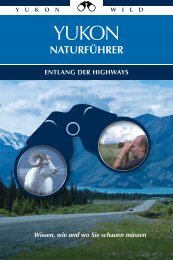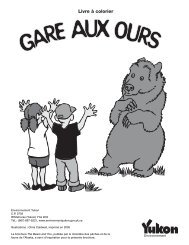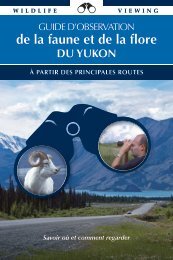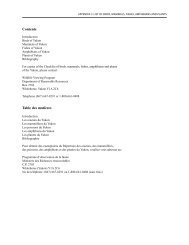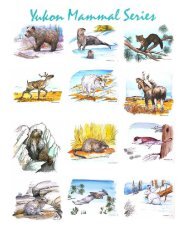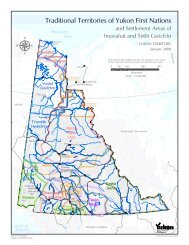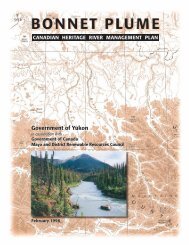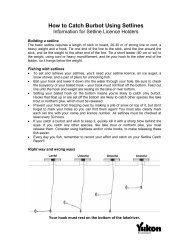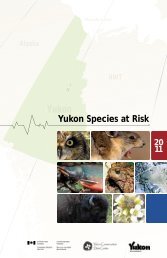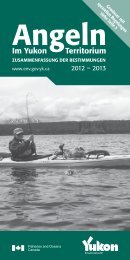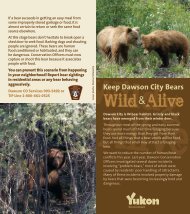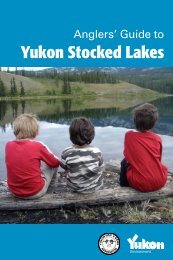Ch. 3 Land - Environment Yukon
Ch. 3 Land - Environment Yukon
Ch. 3 Land - Environment Yukon
You also want an ePaper? Increase the reach of your titles
YUMPU automatically turns print PDFs into web optimized ePapers that Google loves.
Contaminant?<br />
In Carcross, the recent removal of<br />
the remains of an old<br />
sternwheeler tugboat from the<br />
Nares River showed how people<br />
can have very different ideas<br />
about this issue. To the local First<br />
Nation, the old boat was a<br />
contaminant, but other people<br />
were more concerned about<br />
losing an important part of the<br />
<strong>Yukon</strong>’s heritage than about<br />
possible pollution from the boat.<br />
Soil and water standards are used to<br />
determine whether or not a site is<br />
contaminated. A contaminated site<br />
contains chemical substances above<br />
the levels set out in the standards. After<br />
reviewing the available information, the<br />
<strong>Yukon</strong> Minister of Renewable<br />
Resources makes the final decision on<br />
whether or not a site is designated as<br />
contaminated.<br />
If a designated contaminated site is<br />
determined to be a threat to public<br />
health or the environment, the person<br />
or corporation responsible for creating<br />
it may be ordered to clean it up. People<br />
who own or occupy a designated<br />
contaminated site also must apply to the<br />
Minister before making any significant<br />
change in the use of the site.<br />
Five sites have been designated as<br />
contaminated under the <strong>Yukon</strong><br />
legislation, and about 70 other sites<br />
are known to be contaminated, but<br />
have not yet been reviewed by the<br />
Renewable Resources Minister.<br />
A railroad tie treatment plant operating<br />
from 1950s to mid 70s on the Nares<br />
River at Carcross used a mixture of<br />
pentachlorophenol, a wood preservative,<br />
and diesel oil to treat the wood.<br />
A 1997 assessment found that the soil<br />
and groundwater at the site were<br />
contaminated, as well as the water<br />
in the river. The contaminated soil<br />
was removed from the site and from<br />
the near-shore river bed.<br />
The contaminated soil is being treated<br />
by a process called land-farming. The<br />
soil was spread on non-porous ground<br />
at an old pumping station outside of<br />
Carcross. There it will be tilled regularly<br />
to expose it to the air so that native<br />
microbes can break down the<br />
hydrocarbons in the soil.<br />
Contaminated soil was land-farmed at<br />
another site, the fire-training area near<br />
the Whitehorse airport. The soil is now<br />
considered to be safe and the area will<br />
be reseeded. Contamination at the<br />
North of 60˚ Petro site in the Marwell<br />
industrial area is being contained. The<br />
Whispering Willows RV Park in Stewart<br />
Crossing has been completely cleaned<br />
up and has been issued a Certificate of<br />
Compliance.<br />
The Marwell tar pit in Whitehorse was<br />
Marwell Tar Pit<br />
designated as contaminated in May<br />
1998, but no decision has been made<br />
yet on cleaning up this site. The <strong>Yukon</strong><br />
government has asked the federal<br />
government to pay the clean-up costs,<br />
but no decision on responsibility has<br />
yet been made 5.<br />
Storage Tank Regulations<br />
These regulations, passed in 1997,<br />
establish requirements for storing<br />
petroleum products and other<br />
hazardous substances on <strong>Yukon</strong> land.<br />
The requirements are for new or altered<br />
storage tanks, both above and below<br />
ground. They specify that tanks must be<br />
removed when they are of no further<br />
use or have been out of service for a<br />
year.<br />
The regulations are aimed primarily at<br />
new tanks and do not set standards<br />
for old storage tanks. A survey<br />
conducted in 1993 estimated that<br />
hundreds of the old tanks scattered<br />
around the <strong>Yukon</strong> could be leaking.<br />
It cost about $27 million to build the Canol Refinery, which was used to<br />
process oil pumped from the oilfields of Norman Wells during World War II.<br />
The facility was closed down and later dismantled after only a year of<br />
operations. It is thought that the tar pit was established when the storage<br />
tanks from the refinery were removed.<br />
A disposal site was needed for the sludge of heavy oil, called tank bottoms,<br />
left in the tanks, so they were dumped into one of the huge earthen berms<br />
that had been built around each of the tanks. For years other parties,<br />
including the Department of National Defence, continued to dump their<br />
waste oil into this well-known site.<br />
In 1958 a man died from exposure after being trapped in the pit. There<br />
have been many calls for a clean-up of this heavily contaminated site, which<br />
has an estimated 27,000 cubic metres of contaminated soil. Several<br />
treatment methods have been investigated; including thermal desorption<br />
(high temperature burning) and biological treatment.<br />
In 1994, the clean-up costs were estimated to be $4 million. To date, no<br />
decision has been made on who should pay for cleaning up the site;<br />
although the <strong>Yukon</strong> government has repeatedly asked the federal<br />
government to take action on this.<br />
C H A P T E R 3 L A N D ❧ 5 9





